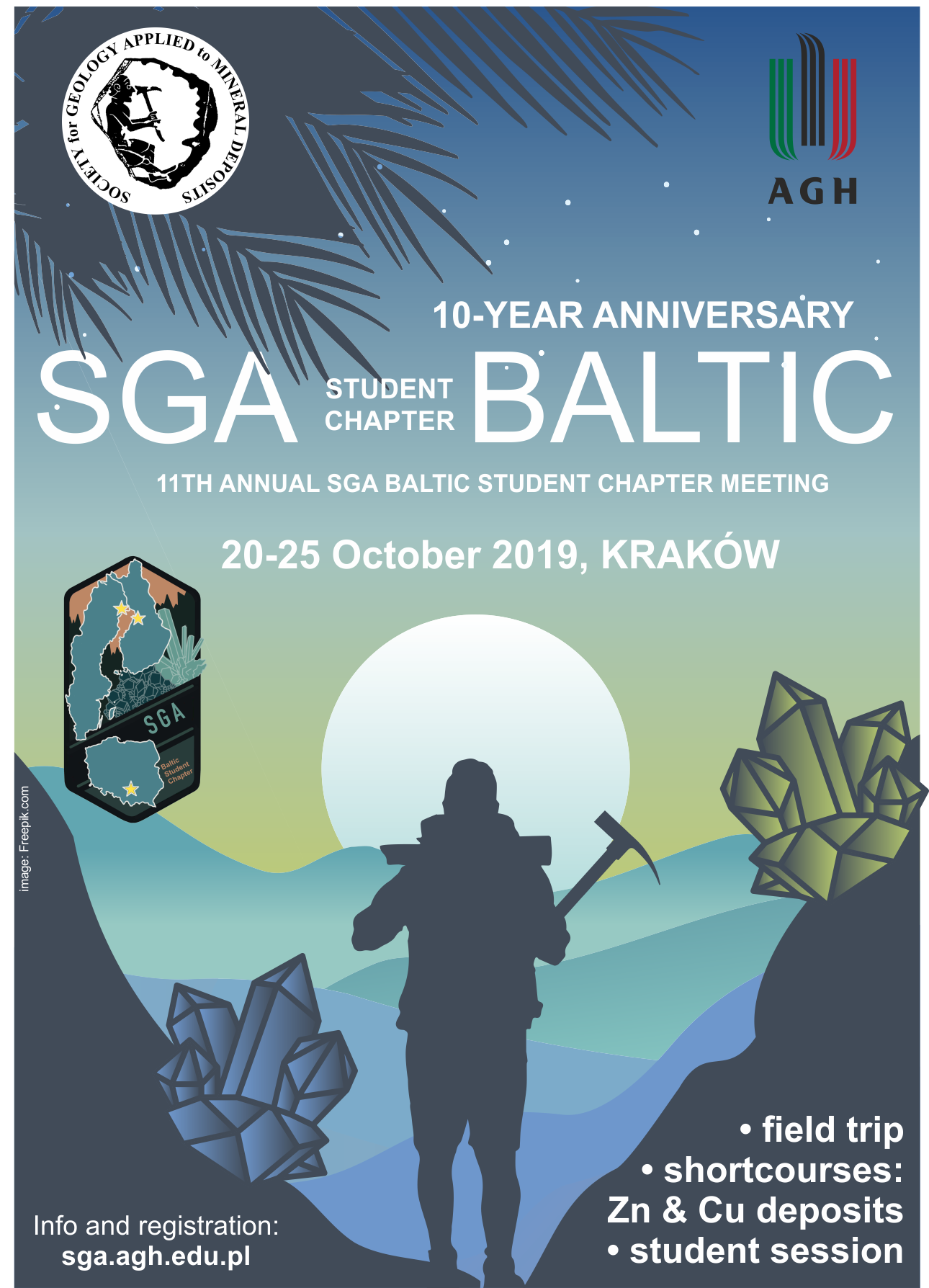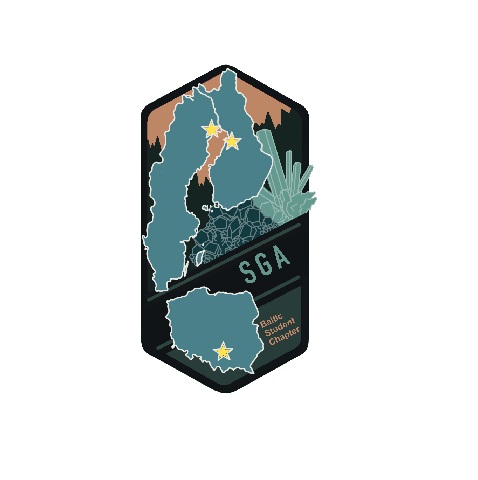11TH ANNUAL SGA BALTIC STUDENT CHAPTER MEETING
This year, the SGA Baltic Student Chapter celebrates its 10th anniversary! It was formed in 2009 as a result of initiative of professors Adam Piestrzyński (AGH) and Pasi Eilu (GTK). Eventually this led to a fruitful long-term collaboration between students from 3 universities in 3 different countries (AGH University of Science and Technology in Kraków, Luleå University of Technology, University of Oulu). To celebrate the anniversary, special annual Chapter meeting was organized at AGH University of Science and Technology in Kraków, where everything started 10 years ago with the first Baltic Chapter meeting. Over the years the event (already 11th) grew and this year we gathered more than 40 participants, not only from AGH University, Luleå University of Technology and University of Oulu, but also from Masaryk University Brno, Charles University in Prague, Montanuniversität Leoben, University of Lorraine, Saint Petersburg State University, National University of Engineering - Peru, University of Nairobi and Mandalay University.

The main theme of this year’s meeting was “sedimentary rock-hosted ore deposits”, with short courses and field trips focused on this type of mineralization.
On Monday (21st of October), participants attended a field trip to the Polkowice-Sieroszowice mine in order to see famous Cu-Ag Kupferschiefer deposit. Tuesday was dedicated to zinc deposits and full day short course started with lectures given by prof. Sarah Gleeson (GFZ Potsdam) who focused on deposits known as SHMS (Sediment hosted massive sulphide deposits) or SEDEX (Sedimentary exhalative deposits). General overview of this class of deposits was followed by detailed examination of examples including Macmillan Pass District in Selwyn Basin in Canada, famous Red Dog district in Alaska and Mesoproterozoic Zn deposits at Mt Isa in Australia. We finished the day with lecture by prof. Murray Hitzman (iCRAG Dublin) about Irish Zn-Pb orefield. Wednesday lectures were focused on copper. Prof. Murray Hitzman gave a general introduction to the sedimentary rock-hosted stratiform copper ore system and then presented a wide range of case studies: Kupferschiefer in Poland and Germany, White Pine in the USA, Chu-Sarysu Basin in Kazakhstan and Central African Copperbelt. To end the day on a high note, exhibition of superb specimens, collected through many years of investigating Kupferschiefer deposit, was prepared by prof. Adam Piestrzyński. Participants had an opportunity to see many different styles of mineralization and spectacular examples of ore textures.

On Thursday (24th of October) participants visited the Mississippi Valley-type deposit in the Olkusz-Pomorzany underground mine, the last operating Zn-Pb mine in Poland. The ore is located in the dolomites of Lower Muschelkalk (middle Triassic) formed as a result of dolomitization of carbonates into “ore –bearing dolostones”. Mineralization occurs as lenses, stratiform layers, breccias and collapse breccias cemented by sulphides. This ore district is famous for its excellent examples of “schalenblende” - dark and light bands of collomorphic sphalerite, usually accompanied by galena and marcasite. Afternoon session started with prof. Stanisław Mikulski (Polish Geological Institute) address to Baltic Chapter members on behalf of the SGA Council. Prof. Dariusz Więcław (AGH) gave a short lecture about the application of organic matter investigation to Kupferschiefer Cu-Ag deposit and then, for something completely different, Roland Butler (Millrock Resources Inc.) gave a talk about nickel sulfide deposits at Voisey's Bay (Canada) which aimed to inspire students to choose a career path in mineral exploration.
Collaboration between AGH University of Science and Technology in Kraków, Luleå University of Technology in Sweden, University of Oulu in Finland and TU Bergakademie Freiberg in Germany resulted in new MSc exchange programme in exploration funded by EIT RawMaterials. It was a topic of a next talk by Władysław Zygo (AGH) who presented opportunities offered for students by EXplORE, highlighted this year activities and encouraged student to apply for this programme. Just before the Baltic Chapter meeting, EXplORE and iTarg3t organized at AGH a 2-day short course led by Tobias Bauer (LTU) and aimed to provide an overview of structural geology and field techniques for more comprehensive understanding and characterization of structural controls on mineralization. Friday morning (October 25th), the last day of the Meeting, was dedicated to student presentation session, with talks covering topics such as Cu-Ag deposit in Shan Plateau (Myanmar), Cu-Mo porphyries (Peru), Cu-Co mineralization from Kunene (Namibia), Bi mineralization form Vardar Zone (Kosovo), secondary U mineralization from Jáchymov (Czechia) and environmental impact assessment of a Pb, Zn smelter from Kabwe (Zambia).
The last but not least was GeoQuiz. Participants were divided into 3 competing groups and set of fun quest aimed to check their knowledge of ore deposits, mineralogy and metal production. On Friday, another EXplORE activity started and students were encouraged to participate in a short course “Stratiform deposits - exploration techniques, data analysis and interpretation, geological modelling, resource calculation” led by Władysław Zygo (AGH) and Andrzej Gądek (mining consultant).

We would like to express sincere gratitude to all the people whose help and dedication made this event possible. We would like to thank our keynote speakers: Prof. Sarah Gleeson and Prof. Murray Hitzman for sharing their experience and knowledge with us. We are grateful to Prof. Jacek Matyszkiewicz, Dean of The Faculty of Geology, Geophysics and Environmental Protection AGH as well as Prof. Anna Siwik, AGH Vice-Rector for Student Affairs for their financial support. We appreciate the effort of Tomasz Chrul and Artur Kuczak mining geologist from Polkowice-Sieroszowice Mine and Tomasz Wójcik mining geologist from Pomorzany Mine. We would like to acknowledge SGA support via Keynote Speaker Program.

